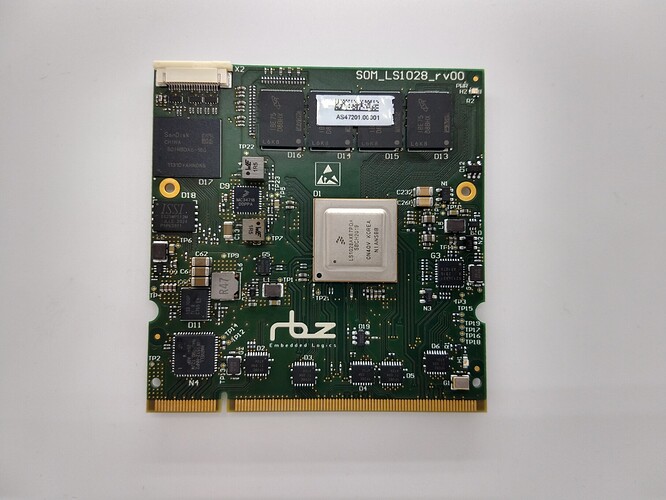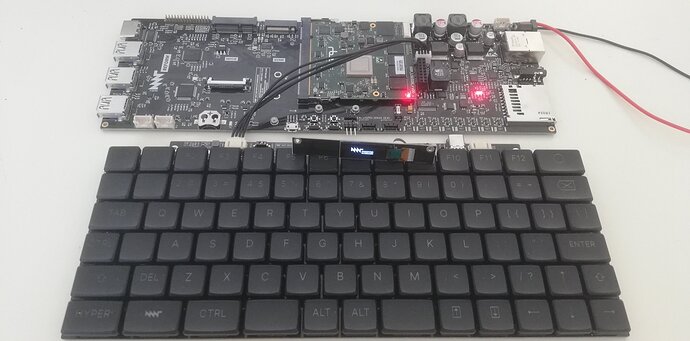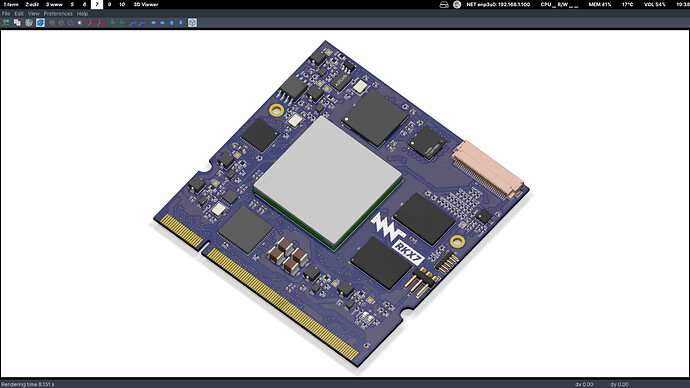Microcode on cpus has been around forever, and only the most fanatical have ever been concerned about. That said, my comment may have been in error. I can’t find anything supporting it from google. I just had a vague memory of a press release about arm chips getting a performance increase from a microcode update relating to OoO execution.
Its not the microcode itself, its the possibility of remote backdoors that annoys/alarms me.
Yeah, I am paranoid of stuff like that, but I also just don’t think corporations deserve that kind of power either.
As for the government, I prefer them to keep out of innocent civilians situations.
Any idea of when a A72 will be available? This chassis is pretty much exactly what I was looking for but A53 with 4gb of RAM is not enough for my hacking.
Could it happen before the end of 2021?
Here is the first photo of the LS1028A module Rev 0:
And here it is in the motherboard powering up for the first time:
Both pictures are taken by RBZ at their lab in Madrid. The first power-up was a week ago. RBZ are now working on the DDR4 memory bringup, which can take several weeks. If everything goes well, we can start bringing up Linux. I have prepared a mainline kernel with patches for the LS1028A devkit already, but it will take some more tweaks to get it going on the MNT Reform.
Then, we’ll start with the crowdfunding for this module.
Thank you for the update. I am looking forward to it.
Here are some renders of the Xilinx Kintex-7 SoM for MNT Reform that I designed over the last weeks. The first revision of the PCB is now in production. The sources are published here: Reform / MNT Reform Kintex-7 SoM · GitLab
Would 8 gigabyes of ram enough have a purpose with a processor with two a72 arm cortex’s in it?
I am wondering if 8 let alone 16 would even have a purpose.
Due it not being a very fast processor I mean compared to even old x86 stuff… like my oldest thinkpad in possession that I rarely use, the thinkpad x200. Which obviously I know is way less secure, just sayin…
Incidently, I have two things to throw to you as ideas:
Trackpoint like functionality, and a usb 3.0 charge cable that can be charged by connecting to a usb slot in some device…
including a powerbank, or a computer for that matter,
Both for the pocket mnt and the regular mnt. 
On an unrelated note, I am surprised there are less blobs needed to run LS1028A then imx8m. So strange…
I am very interested though in the Risc-V starfive quad core version they are supposedly developing though. 
I hope that can be used for this project, someday.
The amount of memory doesn’t really have anything to do with the number of cores.
Oh okay, so, are you saying that it wouldn’t be a waste of resources to get more than 8gb for the mnt reform with the LS1028A?
Yes, because having a lot of memory can help with other use cases. For example, compiling/linking large programs or using many browser tabs or browsers in parallel. Or using half of the memory for another virtualized OS.
Moreover, many programs are badly optimized for multi-core and rely on faster single-thread performance. This is where the out-of-order nature and prediction features of Cortex-A72 help significantly. Of course, these also introduce new vulnerabilities. It is a tradeoff that everyone can make for themselves.
Our goal is to offer many architecture choices/configuration for the same device. This way, you can experiment, upgrade and don’t have to throw your chassis away for a longer time.
That is fascinating, I didn’t know that out of order gave such advantages…
Cool!
Too bad it has weaknesses… oh well though. one less blob anyways. 
Still, good to hear!
Thanks for the info!
ddr4 controller blob aka…
whether it is secure or not, blobs are meh…
But yeah, speed is also good too.
I look forward especially to hearing about the starfive processors available.
Whether its the quad core one, or the dual core. 
I want to know how people like them aka.
Extremely very much looking forward to the possibility of an FPGA core which I can randomly swap out. I do like the idea of seeing whether a RISCV core might be a doable alternative for the SoM brain module, however slow it might end up ultimately being.
A PowerX compatible instruction set might be another option for the FPGA core too. The options themselves would imply that a user-controllable fabric could end up being “safer” for the ultimately paranoid amongst us.
ARM is doing a good job, but the firmware signing keys are typically not user-controlled, which means users can’t modify or sometimes even really implement, a secure boot or any of the trusted computing features on the average arm.
So all this is a good direction, and I’m excited to see what comes out the workshops next.
(BTW, really liking the MNT Reform I received. The keyboard is something I’m getting a lot more used to, and I like the key action. It was a good choice.)
I myself look forward to Starfive’s quad core version for the mini version, whenever it gets to beta or stable, meaning there will be a crowdfunding upon stable.
Though, even 1028A for the mini would be nice. I would assume, smaller devices use less battery and cpu is used less. The only drawback is that there is less room for stuff in general, battery, ram, etc…
This project in general is awesome. I may have been wrong, if the mini costs 800$ even, I would probably still buy it. No idea how much it will cost though.
I hope there is an option for ssd flash drives for it though, instead of nvme solid state drives.
Because of its size, etc… and that flash drives probably use less electricity.
I bet we could get the current generation Power9 CPU to run at very low power & more than reasonable performance. You could sell last generation’s server/workstation hardware in next generation’s laptop. It could also be thinner, have a case-heatpipe system, and have ECC RAM. I’d really appreciate it if it had an OLED screen, a webcam (w/ hardware off switch), a nipple, and a touchpad, and no window. I want to use it like a normal computer and carry it around with me. Why not look into some rugged case designs? A load of ThinkPad enthusiasts are dying to leave the Lenovo ecosystem because of their consistently customer-hated choices. You could buy old used Power9 CPUs, run them at low power like this guy did with the Ryzen: https://www.reddit.com/r/hardware/comments/k3iobs/psa_performance_doesnt_scale_linearly_with/ (recommended read for understanding my pitch). Let’s show these big companies we can have a 100% performant modern computer that beats the socks off of their design choices that make the homogenization of milk scam seem like small fries (to those who aren’t aware, mothers receiving milk deliveries used to judge its quality by milk fat that rose to the top of the container, before homogenization).
Does it have the same problem with the secrets in the memory controller?
What concerns Power 9, I suspect you’re correct in that the cores would be reasonably energy efficient at the right point of the voltage / frequency curve, but the cores are not the only component using power on a modern CPU. Things like memory controllers (Sforza has 8 channels!), high speed I/O (48 PCIe 4.0 lanes) and interconnects between cores (I remember reviews of AMD EPYC CPUs calling this out as requiring more power in comparison to Ryzen) use quite a lot of power.
Raptor report around 30W idle power consumption for the CPU (ignore wall measurements, but the OCC measurements should be accurate enough).
I imagine cutting this down would require redesigning the chip to e.g. remove memory controllers, use more power efficient core interconnects, etc.
What concerns secrets in the memory controller, my understanding is that Power 9 can be used with completely open firmware, but Power 10 needs blobs.
I am very curious about further info on this, also…
I would very much enjoy openpower if someone made something akin to the idea of microwatt, only a very stable version and one that at most uses 10-15W when running without being plugged in doing web surfing only, or at best, under 1W.
I know that sounds insane… because it probably is. xD
But I would absolutely love this.
Problem is, it might take a decade to get it to do that with only 1W + be as stable as Arm64, if I had to guess. But maybe somewhere in between would take half as long or less?
Just as an obvious, I look up processors that use low electricity every so often, but I am not an expert on this, so these are just shots in the dark.
That also being said, some Risc-V processors use extremely small amounts of electricity, I think polarfire is one of them?
I will mention though, I would want it to be at least as fast as LS1028A, be as useable as that or better, not require any backdoor blobs, be libre if possible, etc…
I assume some of this might be insane, feel free to tell me how much of it is.
I am curious…
@minute How likely is the intel NUC processor asked about on the mastodon? Having to swap motherboards makes less attractive, but is definitely not a deal breaker. In fact, I’m sure I know people that would like to have my current mnt motherboard.
Currently very unlikely, as the Intel design documentation required to make a carrier for Compute Element are behind NDA, and they would also want us to use a specific ITE controller chip on the carrier that is not available in public catalogs. The way their whole solution is set up is very much against the guiding principles of MNT Reform, unfortunately.



